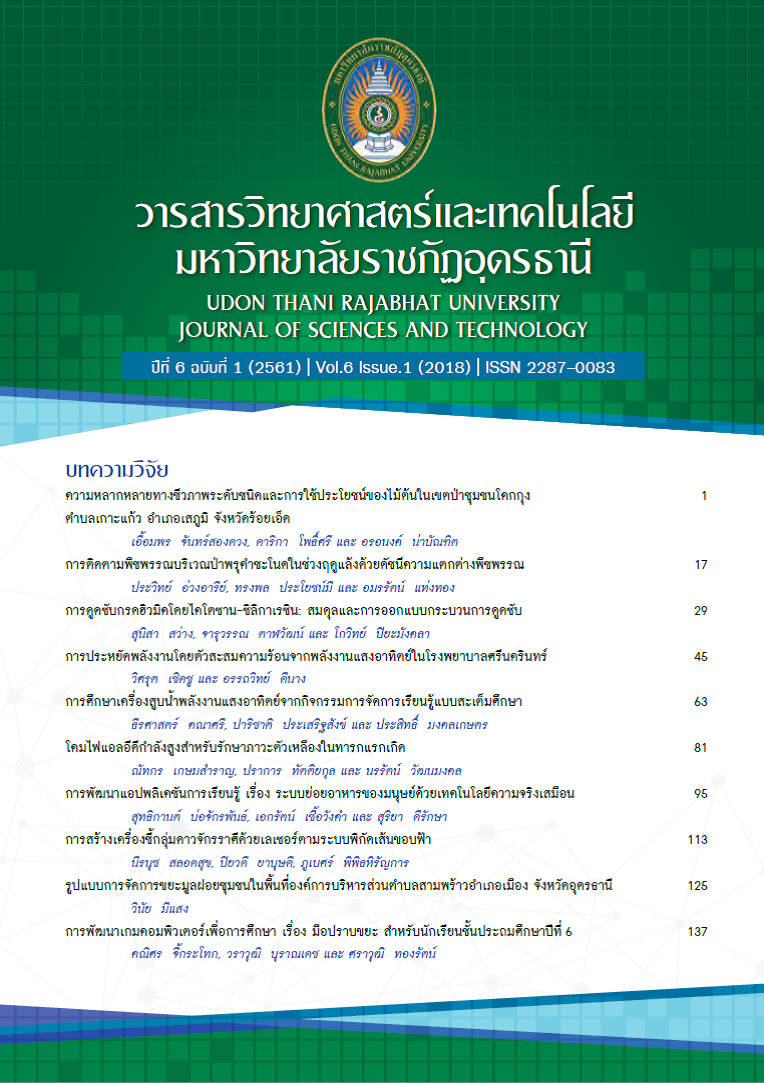ADSORPTION HUMIC ACID BY CHITOSAN-SILICA RESIN: EQUILIBRIUM AND DESIGN OF ADSORPTION PROCESS
Main Article Content
Abstract
This research studies batch adsorption in laboratory scale for the removal of humic acid by chitosan-silica resin as an adsorbent. It was found that adsorption capacity of 0.2 g of chitosan silica resin with varying initial humic acid concentration of 13.5, 17.5 and 22.5 mg/L were 0.86, 0.92 and 1.15 mg/g, respectively. The equilibrium of adsorption was studied by Langmuir and Freundlich equations. It was found that the equilibrium of adsorption followed by Freundlich equation. Batch design to achieve 100% of humic acid removal for 1 L was 91.3 g.
Article Details
Section
Research Article
References
Avena, M., & Koopal, L. (1999). Kinetics of humic acid adsorption at solid-water interfaces. Environmental Science & Technology, 33(16), 2739-2744.
Crittenden, B., & Thomas, W. J. (1998). Adsorption technology & design. Woburn: Butterwouth-Heinemann.
El-Geundi, M. S., Nassar, M. M., Farrag, T. E. & Ahmed, M. H. (2013). Methomyl adsorption onto cotton stalks activated carbon (CSAC): equilibrium and process design. Procedia Environmental Sciences, 17, 630-639.
Illés, E., & Tombácz, E. (2006). The effect of humic acid adsorption on pH-dependent surface charging and aggregation of magnetite nanoparticles. Journal of Colloid and Interface Science, 295, 115-123.
Kenned Oubagaranadi, J. U., Sathyamurihy, N., & Murthy, Z. V. P. (2007). Evaluation of fuller’s earth for the adsorption of mercury from qqueous solution: A comparative study with activated carbon. Journal of Hazardous Materials, 142, 165-174.
Kumar, M. R. (2000). A review of chitin and chitosan applications. Reactive & Functional Polymers, 46, 1-27.
Rinaudo, M. (2006). Chitin and chitosan: properties and application. Progress in Polymer Science, 31, 603-632.
Ritthichai, A., & Muncharoen, S. (2014). Dye removal of textile wastewaters using crab shell activated carbon. Burapha Science Journal, 19(1), 131-140.
Rodrigues, P. M., Esteves da Silva, J. C., & Antunes, M. C. (2007). Factorial analysis of the trihalomethanes formation in water disinfection using chlorine. Analytica Chimica Acta. 595, 266–274.
Saadi, R., Saadi, Z., Fazaeli, R., & Fard, N. E. (2015). Monolayer and multilayer adsorption isotherm m odels for sorption from aqueous media. The Korean Journal of Chemical Engineering, 32 (5), 787-799.
Shah, B., Jadav, P., & Shahb, A. (2013). Sorption of phosphamidon onto microwave synthesized zeolitic material. Environmental Progress & Sustainable Energy, 33(1), 114-122.
Suttanan, R., & Piyamongkala, K. (2011). Kinetic and thermodynamic adsorption of methylene blue by modified rice husk. The Journal of KMUTNB, 21(2), 337-348.
Yang, Y., Chun, Y., Sheng, G., & Huang, M. (2004). pH-dependence of pesticide adsorption by wheat-residue-derived black carbon. Langmuir, 20, 6736-6741.
Zhang, X., & Bai, R. (2003). Mechanisms and kinetics of humic acid adsorption onto chitosan-coated granules. Journal of Colloid and Interface Science, 264, 30-38.
Crittenden, B., & Thomas, W. J. (1998). Adsorption technology & design. Woburn: Butterwouth-Heinemann.
El-Geundi, M. S., Nassar, M. M., Farrag, T. E. & Ahmed, M. H. (2013). Methomyl adsorption onto cotton stalks activated carbon (CSAC): equilibrium and process design. Procedia Environmental Sciences, 17, 630-639.
Illés, E., & Tombácz, E. (2006). The effect of humic acid adsorption on pH-dependent surface charging and aggregation of magnetite nanoparticles. Journal of Colloid and Interface Science, 295, 115-123.
Kenned Oubagaranadi, J. U., Sathyamurihy, N., & Murthy, Z. V. P. (2007). Evaluation of fuller’s earth for the adsorption of mercury from qqueous solution: A comparative study with activated carbon. Journal of Hazardous Materials, 142, 165-174.
Kumar, M. R. (2000). A review of chitin and chitosan applications. Reactive & Functional Polymers, 46, 1-27.
Rinaudo, M. (2006). Chitin and chitosan: properties and application. Progress in Polymer Science, 31, 603-632.
Ritthichai, A., & Muncharoen, S. (2014). Dye removal of textile wastewaters using crab shell activated carbon. Burapha Science Journal, 19(1), 131-140.
Rodrigues, P. M., Esteves da Silva, J. C., & Antunes, M. C. (2007). Factorial analysis of the trihalomethanes formation in water disinfection using chlorine. Analytica Chimica Acta. 595, 266–274.
Saadi, R., Saadi, Z., Fazaeli, R., & Fard, N. E. (2015). Monolayer and multilayer adsorption isotherm m odels for sorption from aqueous media. The Korean Journal of Chemical Engineering, 32 (5), 787-799.
Shah, B., Jadav, P., & Shahb, A. (2013). Sorption of phosphamidon onto microwave synthesized zeolitic material. Environmental Progress & Sustainable Energy, 33(1), 114-122.
Suttanan, R., & Piyamongkala, K. (2011). Kinetic and thermodynamic adsorption of methylene blue by modified rice husk. The Journal of KMUTNB, 21(2), 337-348.
Yang, Y., Chun, Y., Sheng, G., & Huang, M. (2004). pH-dependence of pesticide adsorption by wheat-residue-derived black carbon. Langmuir, 20, 6736-6741.
Zhang, X., & Bai, R. (2003). Mechanisms and kinetics of humic acid adsorption onto chitosan-coated granules. Journal of Colloid and Interface Science, 264, 30-38.


